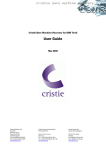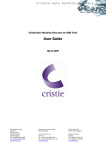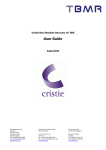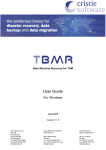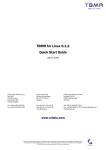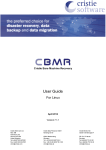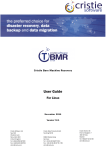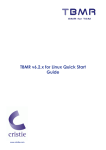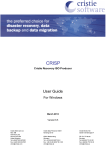Download User Guide - Cristie Data Products GmbH
Transcript
Cristie Bare Machine Recovery for TSM User Guide November 2009 Cristie Software Ltd New Mill Chestnut Lane Stroud GL5 3EH United Kingdom Tel:+44(0)1453 847000 Fax:+44(0)1453 847001 [email protected] Cristie Data Products GmbH Nordring 53-55 Cristie Nordic AB Gamla Värmdövägen 4 63843 Niedernberg Germany Tel: +49 (0) 60 28/97 95-0 Fax: +49 (0) 60 28/97 95 7-99 [email protected] SE-131 37 Nacka Sweden Tel:+46(0)8 718 43 30 Fax:+46(0)8 718 53 40 [email protected] Copyright © 2003-2009 Cristie Software Ltd. All rights reserved The software contains proprietary information of Cristie Software Ltd; it is provided under a license agreement containing restrictions on use and disclosure and is also protected by copyright law. Reverse engineering of the software is prohibited. Due to continued product development this information may change without notice. The information and intellectual property contained herein is confidential between Cristie Software Ltd and the client and remains the exclusive property of Cristie Software Ltd. If you find any problems in the documentation, please report them to us in writing. Cristie Software Ltd does not warrant that this document is error-free. No part of this publication may be reproduced, stored in a retrieval system, or transmitted in any form or by any means, electronic, mechanical, photocopying, recording or otherwise without the prior written permission of Cristie Software Ltd. IBM Tivoli Storage Manager (TSM) and TIVOLI are trademarks of the IBM Corporation. PC-BaX, Cristie Storage Manager (CSM), SDB, TBMR (Bare Machine Recovery for TSM) and CBMR (Cristie Bare Machine Recovery) are trademarks of Cristie Software Ltd. Cristie Software Ltd New Mill Chestnut Lane Stroud GL5 3EH UK +44 (0) 1453 847000 Internet E-Mail: [email protected] Website: http://www.cristie.com 1 Contents 1 Overview 1.1 1.2 1.3 1.4 2 Context........................................................................................................................................ 2 Prerequisites .............................................................................................................................. 2 Backup Process ......................................................................................................................... 2 Recovery Process....................................................................................................................... 3 The TBMR Create Configuration Tool 2.1 2 4 Creating the Configuration Information .................................................................................... 4 3 64-bit Versions of Windows XP, Vista, Windows 7, 2003 and 2008 6 4 Using a TSM Backup for Disaster Recovery 7 5 Encrypted Backups 8 6 Image Backups 10 7 Restoring your System 11 7.1 7.2 8 Booting the DR Console........................................................................................................... 11 WinPE 2 Based TBMR Recovery Console ............................................................................... 12 7.2.1 TBMR Recovery Console Main Menu.............................................................................. 13 7.2.2 Start Automatic Recovery Wizard.................................................................................... 14 7.2.3 Start Manual Recovery Sequence .................................................................................. 24 7.2.4 Tools ................................................................................................................................. 34 7.2.5 Show Log and Error Reports............................................................................................ 55 7.2.6 Copy Log and Error Report Files...................................................................................... 56 7.2.7 Close Recovery Console and Reboot .............................................................................. 57 Index 58 2 1 Overview 1.1 Context This document describes the essential elements of TBMR and Disaster Recovery based upon a tailored WinPE recovery module. It is based upon version 6.2.2 of the software. 1.2 Prerequisites An Intel x86, x64 or ia64 based processor, with 640MB RAM and 20MB free disk space running one of the following operating systems: Windows XP Windows 2003 Windows Vista Windows 7 Windows 2008 Both 32 and 64-bit versions of XP, 2003, Vista, 7 and 2008 (including Core and R2) are supported. On Itanium (ia64) only Windows 2003 and 2008 are supported. TBMR requires a minimum TSM client version of 5.5.x.x on x86/x64/ia64. This must be installed and correctly configured prior to the installation of TBMR. Windows 2008 R2 requires a minimum client version of 6.1.2.0. Ensure that either the BA Client Open File Support is installed and configured correctly. Select either LVSA or VSS as appropriate. This allows important OS files that are normally held open by the OS to be successfully backed up by TSM. TBMR will not successfully recover the OS without these files. 1.3 Backup Process Cristie Bare Machine Recovery for IBM Tivoli (TBMR) allows you to perform a bare machine recovery of your system direct from an IBM Tivoli Storage Manager (TSM) backup. To do this you must first prepare your system using the process outlined below. 1 2 3 Installation (refer to the TBMR Installation and Licensing Guide) Install the TBMR configuration software License the Software (using a Trial or Full license)Using a TSM Backup for Disaster Recovery (page 11, page 4, page 7) Configuration Save the Configuration parameters. Update when significant hardware changes are made. Ensure that you have a bootable media (normally the WinPE DR CD-ROM). Backup system and user data Perform regular standard TSM backups (page 7) as required. You will then be ready to Restore the system from the Disaster Recovery Backup (page 11). Overview 3 1.4 Recovery Process In the event of a disaster, having previously taken a TSM backup of the system and stored the configuration information, Windows PE mode DR enables you to restore your system to the state at the last TSM backup. The TBMR recovery console is supplied on CD-ROM and if your machine supports bootable CDROMs (most PCs do) this is the most convenient way to boot the DR module. If the system does not support bootable CD-ROMs you can boot from the network. Contact Cristie for details on how to set this up. Windows PE offers several advantages namely: a familiar Windows GUI the ability to inject new mass storage drivers during the boot process all variations of dynamic disks are supported (i.e. mirrored, spanned, striped and RAID-5) NTFS volumes/partitions are created natively support for NTFS mounted folders (junctions) and hard links the restored backup contains the original file security information The WinPE recovery process has 5 main steps 1 Load Configuration data 2 Rebuild storage devices (hard disks) 3 Restore OS files from a TSM backup 4 Dissimilar Hardware (if necessary) 5 Boot into Windows 4 2 The TBMR Create Configuration Tool Configuration information is saved by default to the TBMRCFG folder on the Windows system partition. This cannot be changed. The Cristie tool that provides this function is called TBMRCfg.exe which is located in the TBMR installation folder (normally Program Files \Cristie\TBMR). This is a command line only tool which is licensed for use initially for a 30 day trial period. A full license is required to use the program beyond the trial period. As part of this process, details about the hard disks, operating system, storage controller(s), network adapter(s) and network settings will be queried and stored. You can override some of these details if you wish. The next sections discuss this process in more detail. 2.1 Creating the Configuration Information To create the configuration manually run a command window and navigate to the folder where TBMR is installed. For example, The TBMR configuration program is called TbmrCfg.exe. Enter the command TbmrCfg.exe /?. This will display the command line options available. The command line options are very simple: /help or /? Shows TbmrCfg usage. This displays the command option summary. The TBMR Create Configuration Tool /format <Drives to format | all> The /format option allows disk volumes other than the Windows drive to be formatted during the recovery. By default only the Windows volume will be formatted. There is an exception to this if Windows is not contained within the first partition of the disk. In that case both the Boot partition and the Windows partition will be configured for formatting. However, regardless of this setting, the WinPE based recovery environment will allow any or all partitions to be formatted. So, for example, if volumes D:, E: and F: are to be additionally formatted during recovery, enter: TbmrCfg.exe /format D,E,F (separate the drive letters using a comma) Enter the following to back up all partitions on all drives on the system: TbmrCfg.exe /format all Volumes mounted on local folders not having a drive letter can be specified like this: TbmrCfg.exe /format D:\MountedVolume where D:\MountedVolume is the folder mount point. An example using both normal partitions and a mounted volume is: TbmrCfg.exe /format D,D:\MountedVolume TbmrCfg stores the configuration in %SystemDrive%\TBMRCFG folder (%SystemDrive% is the drive associated with the Windows folder, usually C:\). This location cannot be changed. NOTE: It is important to remember that the TBMR configuration must be created before the BA Client backup is made. Cristie suggests that this is done by creating a job to run on the TSM Scheduler containing a script that calls the TbmrCfg.exe program installed in the TBMR installation folder. 5 6 User Guide Cristie Bare Machine Recovery for TSM 3 64-bit Versions of Windows XP, Vista, Windows 7, 2003 and 2008 On these 64-bit OS's, files additional to the standard TSM backup dataset must be copied and saved. These include boot files and SystemState objects which are not normally backed up by the BA Client on these OS's. Some of the additional files backed up are also locked at the time of backup and must be backed up using the Open File Manager VSS. So when TBMRCfg runs it invokes VSS to take a snapshot copy of these extra files (see below). 7 4 Using a TSM Backup for Disaster Recovery TBMR allows a previously created TSM backup to be used as a DR backup. As long as the TBMR configuration has been created (see previous section) and a TSM backup is performed afterwards, then it will be possible to recover the system using the DR environment. This document does not describe how to create TSM backups. Please refer to your TSM Administrator's Guide for details. 8 User Guide Cristie Bare Machine Recovery for TSM 5 Encrypted Backups TBMR supports encrypted TSM backups. This can be enabled in TSM by adding the line: INCLUDE.ENCRYPT "*:\...\*" to the dsm.opt file. TBMR works by creating the system configuration into the folder TBMRCFG. So the line above would mean that when the TSM backup is created, the TBMRCFG folder is also encrypted. This is not a problem though, but would mean that you will be prompted for the password during the recovery. If you wish to avoid this prompt add this additional line to dsm.opt after the line above: EXCLUDE.ENCRYPT "*:\TBMRCFG\*" You can also choose to always prompt for the encryption key password or have it stored locally. You will be prompted for the encryption key thus: You should also select the appropriate encryption algorithm for your backup. If the folder containing the TBMR configuration has been encrypted then during the recovery you will be prompted for the password: If the configuration folder has been excluded from the encryption (as described above) you will be prompted for the password during the 'Restore Files' phase of the DR. Please enter the same password you entered during the backup. Encrypted Backups Note: If you have elected to have the password stored locally (via the BA Client Preferences menu) and the TBMR configuration has been created post this change, then you will not be prompted for the password during the recovery. You may also need to perform a 'dummy' backup first to get the password stored locally before generating the TBMR configuration. 9 10 User Guide Cristie Bare Machine Recovery for TSM 6 Image Backups TBMR supports both incremental and image backups. However, for image backups, it is essential that in addition to the image backup, an incremental backup of the TBMRCFG folder is made to the same Node. This is because it is not possible to retrieve the configuration details from an image backup. If this extra incremental backup is not made then it will not be possible to perform a DR. Note also that it is not possible to restore an image backup to a smaller disk partition. 11 7 Restoring your System If the situation arises where you need to recover your system, you have all the necessary information on the DR System CD, the DR Configuration Disk (or file) and the TSM Backup to get your system up and running in minimal time. The restore process requires little user intervention. 7.1 Booting the DR Console Insert the bootable DR CD/DVD-ROM and reboot the machine. You will be prompted to Press any key to boot from the CD or DVD. This prompt is only made for a few seconds before the system will attempt to boot the underlying OS, so you will need to react quickly! 12 7.2 WinPE 2 Based TBMR Recovery Console When the WinPE 2 TBMR Console is booted, a Windows installation-like boot procedure is started. During the boot process WinPE 2 drivers for your Plug and Play devices will be loaded - in particular the Mass Storage devices and Network Adapters. When the WinPE 2 system has booted it is possible to remove the CD if you wish. Upon successful boot the following licence Agreement will be displayed. Press I Accept to continue. Selecting I Decline will reboot the system. You must agree to the Licence Terms and Conditions to perform a Disaster Recovery. Note that the DR Console will automatically reboot 72 hours after starting. This is an operating limitation of the Microsoft Windows PE 2 environment. When this sequence completes the TBMR Recovery Console will be shown. Restoring your System 13 7.2.1 TBMR Recovery Console Main Menu When you boot the WinPE 2 DR environment, you will see the TBMR Recovery Console Main Menu as below. You may configure the displayed date/time and the keyboard layout, by pressing the icon. 14 User Guide Cristie Bare Machine Recovery for TSM By default the standard display uses US layout, but this may be changed to one of the listed alternatives. Select Date, Time and Time Zone to configure the locale. 7.2.2 Start Automatic Recovery Wizard Select this option to commence a automatic DR sequence. Restoring your System 15 Press Next> to proceed to the first step of the sequence. Press Cancel to abort the recovery sequence at this point. You will then be presented with a dialog prompting you to select the type of the TSM restore. At the moment only restoring from a TSM node is supported. A future release will support restoring from a backupset stored on a disk or removable media. Press Next> to continue. Specify TSM Details and Recovery Date/Time The first step of the automatic recovery identifies the location of the TSM Server and Node used to back up the Client. 16 User Guide Cristie Bare Machine Recovery for TSM Selecting the Point-in-time (PIT) restore mode will allow the system to be recovered to a point closest to the specified date/time. The version of any files restored are closest to but not younger than the specified date/time. If required to restore from an older date, selecting the down-arrow in the day/month field brings up a calendar. This can be used to scroll the months/years backwards and forwards as necessary. Note, a future date will result in the latest backup being recovered. If PIT mode is not selected then, by default, the latest file versions will be restored.Then select Next> to continue. If the backup including the TBMR configuration folder TBMRCFG is encrypted, a prompt for the encryption password will be displayed if not held locally: Enter the password used during the backup. Restoring your System 17 Note: TBMR assumes that TCP/IP is the communication method used between the Client and the Server. Other TSM communication methods are not currently supported. Press OK> to proceed. Select Filespaces To Restore The next step prompts for the filespaces to restore. Generally each filespace represents a disk partition or volume. Put a tick against each filespace that should be restored. Note that the system and boot partitions (even if on different partitions) will always be restored by default. Click Next> to continue to the next step. 18 User Guide Cristie Bare Machine Recovery for TSM Confirm Volume Layout The next step in the automatic recovery shows a list of the disks and partitions to be recovered. The left-hand panel of the display shows the original disk layout and partitions. The right-hand panel shows how the recovered disks will be partitioned after the recovery. A green tick box next to a disk signifies that the disk and its underlying partitions will be left intact. Placed next to a partition/volume means that the corresponding partition/volume WILL NOT be partitioned. A red exclamation mark placed next to a disk means it WILL be partitioned during recovery. Placed next to a partition or volume means that the corresponding partition/volume WILL be partitioned. A red/white exclamation mark be partitioned. placed next to a disk means at least one partition/volume WILL Restoring your System 19 Click on the Icon Help button to display a summary of this: When the recovery is to the original system the contents of both panels will look similar if the number of disks is the same. Possibly the disk sizes will be different (as in the above example). When performing a recovery to a dissimilar system the disk mapping can be much more complex. Some of the criteria used to judge the disk mapping match are: disk geometry (tracks, cylinders and sectors) disk capacity if currently formatted, the disk signature You may right-click on any disk shown in the right-hand panel to select whether the disk will be formatted or not. 20 User Guide Cristie Bare Machine Recovery for TSM Any attempt to turn off formatting incorrectly will result in this error. You may also right-click on a partition to allow you to selectively modify the partition parameters or to remove it altogether. You may Modify the following partition parameters: size in MB (only if disk is shown with a label format (yes/no) The screenshot below shows this. ) Restoring your System Select Delete to remove the partition completely (only if disk is shown with a 21 ). If you attempt to either not format or delete a Windows system partition, an error such as this will be displayed. At this stage nothing has happened to the disks. Press Next> to continue with the recovery. Proceed With The Recovery Before continuing with the actual recovery a final warning screen is displayed. If you are happy with the recovery configuration, press Finish. This will commence the actual recovery. Note: This procedure will completely destroy any existing data on disks selected for format (i.e shown with a ). Disks or partitions tagged as no format (i.e. shown with a ) will however be retained. 22 User Guide Cristie Bare Machine Recovery for TSM Disk Recovery Sequence The recovery sequence begins by preparing the disks selected for the recovery. This involves: disk mapping original layout to new cleaning (removing any existing disk partitions) removing any existing dynamic volume databases re-creating the partitions converting to dynamic volumes if required formating to the required partition type. Restoring your System 23 The next step is to recover the backups to the selected target disks/partitions. A new window appears containing the restore status of recovered files and a progress bar which indicates how much of the backup has been restored.. This display also shows the recovery statistics in terms of time, size and throughput. This process may take some minutes if the backups are large. You may select the Abort button to terminate the file recovery process, but this may leave the disk or partition in an unpredictable state which may be unusable. If any errors occur during the recovery, an error message will be shown in the window. Refer to the logs post recovery to establish the cause of any error. Press Close to return to the Recovery Console main menu. At this point you may want to view the recovery logs and perhaps copy the logs to a local device or remote share before selecting to reboot. Note that recovery logs are also saved to the recovered system to the TBMR installation sub-folder 'Temp' (e.g. "C:\Program Files\Cristie\TBMR\Temp"). 24 User Guide Cristie Bare Machine Recovery for TSM Disk Scaling In situations where the target system has fewer or smaller disks than the original system, disk scaling will come into effect. For example, The above example shows a recovery from an original system with 4 physical disks to a target system with only 1 disk. The target disk is also much smaller than the original disks. In this case TBMR will select as many disks to recover as possible (in this case only 1 disk - the boot disk). In addition it will scale the partitions down in proportion to their original size and occupancy. This can be complicated by having say mirrored dynamic volumes when the mirror will need to be broken - if only 1 disk exists on the target (or it has been tagged as not to modify). Note 1: The Volume Layout dialog will only show disks in the left hand panel that can be recovered. Note 2: During a recovery to a system with larger disks the partition sizes will remain the same as the original by default. However, in this case, it is possible to increase partition size manually during the recovery by right-clicking on the partition icon and selecting Modify. 7.2.3 Start Manual Recovery Sequence Select this option to commence a manual DR sequence. This option will stop after each step in the DR sequence allowing the DR to be aborted or the step to be repeated with different parameters. Locate Configuration The first step of the manual DR sequence is to provide the location of the DR configuration. Restoring your System 25 Press Next> to proceed to the first step of the sequence. Press Cancel to abort the recovery sequence at this point. You will then be presented with a dialog prompting you to select the type of the TSM restore. At the moment only restoring from a TSM node is supported. A future release will support restoring from a backupset stored on a disk or removable media. 26 User Guide Cristie Bare Machine Recovery for TSM Press Next> to continue to: Specify the location of the TSM Server and Node used to back up the Client. Selecting the Point-in-time (PIT) restore mode will allow the system to be recovered to a point closest to the specified date/time. The version of any files restored are closest to but not younger than the specified date/time. If required date is not the current WinPE date, selecting the downarrow in the day/month field brings up a calendar. This can be used to scroll the months/years backwards and forwards as necessary. Note, a future date will result in the latest backup being recovered. Restoring your System 27 Then select Next> to continue. If the backup including the TBMR configuration folder TBMRCFG is encrypted, a prompt for the encryption password will be displayed if not held locally: Enter the password used during the backup and press OK>. Successful extraction of the configuration from the server is confirmed with the following dialog: Select Finish and control returns to the next step in the Manual Recovery sequence. 28 User Guide Cristie Bare Machine Recovery for TSM Create Partition and Volumes The next step of the manual recovery process is to configure the target disk partitions and volumes. Select Next> to display the Volume Layout dialog. This screen shows the original disk layout against that of the target system. Naturally the target disk layout could be very different to the original. TBMR will attempt to match the disks using its own in-built criteria. Some of the criteria used to judge the match are: Restoring your System disk geometry (tracks, cylinders and sectors) disk capacity if currently formatted, the disk signature 29 However, it is possible to change the partition size or opt to tag/untag whether or not a partition should be formatted. To do this right click on the the disk icon and the following configuration dialog is displayed. The indicator shown next to the disk icon indicates whether that disk will be left intact or not. A red exclamation mark indicates that the disk will be re-partitioned and/or formatted. A green tick indicates that the disk will be left intact. Disks and partitions are discussed in more detail in the Automatic Recovery - Recovery Details section. 30 User Guide Cristie Bare Machine Recovery for TSM Press <Back to return to the previous step, Finish to commence the active part of this step or Cancel to abort. If you are happy with the recovery configuration, press Finish. This will commence the actual recovery. Note: This procedure will completely destroy any existing data on the disks selected for recovery. Disks or partitions tagged as no format will however be retained. The Create Partitions and Volumes step begins by preparing the disk selected for the recovery. This involves: Restoring your System disk mapping original layout to new cleaning (removing any existing disk partitions) removing any existing dynamic volume databases re-creating the partitions converting to dynamic volumes if required formating to the required partition type. Press Next> to continue with the recovery. Restore Files The next step of the manual recovery process is to restore the DR backup files. Press Next> to identify the TSM filespaces that should be recovered. Note that the SystemState filespace will always be recovered by default. 31 32 User Guide Cristie Bare Machine Recovery for TSM Press Next> to commence the restore of the TSM filespaces to their target disks/partitions. Finally, a new window appears containing the restore status of recovered files and a progress bar which indicates how much of the backup has been restored.. This display also shows the recovery statistics in terms of time, size and throughput. This process may take some minutes if the backups are large. You may select the Abort button to terminate the file recovery process, but this may leave the disk or partition in an unpredictable state which may be unusable. If any errors occur during the recovery, an error message will be shown in the window. Refer to the logs post recovery to establish the cause of any error. When the restore files step completes the following dialog is displayed. Select Finish and control returns to the next step in the Manual Recovery sequence. Restoring your System 33 Make Bootable The final step in the manual recovery sequence is to make the original disk 'bootable'. This involves re-creating the MBR of the boot disk and modifying the registry with the new disk GUID. Press Next> to commence the make bootable step.. A new dialog window opens summarising the success or failure of the operation.. Press Close to complete the step and return to the Manual Recovery Wizard. 34 User Guide Cristie Bare Machine Recovery for TSM 7.2.4 Tools There are a few tools that can assist with the recovery process. They are all collected under this command button. The options available are: Load a driver Configure the network Dissimilar hardware wizard Advanced options Setup Backup Locations Copy key repository Selecting Load a driver allows a new driver to be installed once WinPE 2 has been booted. The driver can be for a mass storage or network card. Drivers for other device types may work, but this is not guaranteed. Selecting Configure the network will start the Cristie Network Configurator tool. This provides extensive facilities to configure network during the DR process. The Dissimilar hardware wizard will allow drivers to be injected into the recovered system when the target hardware has different devices from the original (e.g. RAID controllers). Advanced options should only be selected when advised to do so by Cristie Support staff. Setup Backup Locations will allow the creation of a pseudo device defining the location of the backup (and the configuration if it included with the backup). This could for example be TSM, tape or a VTD. Copy key repository will allow a key repository file to be copied to the local WinPE 2 environment. This will then be used by default to locate backup keys for any encrypted backups. If the system is unable to locate the correct key the User will be prompted for the corresponding pass phrase (or key if known). Restoring your System Cristie Network Configurator Tool This is a very powerful tool that provides extensive facilities to configure the network during the recovery process. It offers the following features: supports multiple NICs configure individual NIC parameters for duplex mode and link speed the ability to select DHCP allocated or static IP addresses the ability to setup DNS and WINS server IP addresses the ability to setup the Network Identification of the recovering system. allow file shares to be set on the recovering system. map/unmap network drives. 35 36 Configure NIC Parameters It is possible to change both the link speed and duplex mode for any NIC detected on the recovering target system. Select the desired NIC (there could be more than one) from the drop down box and then select Update.... Restoring your System The resulting display offers numerous NIC properties that can be changed. This property list is dependent upon the NIC - i.e. not all properties will be available for all NICs. 37 38 User Guide Cristie Bare Machine Recovery for TSM To change the NIC speed or duplex setting, select the corresponding Property from the dialog and then select the required value from the Value drop down box as shown below: Again note that the speed/duplex settings available are NIC dependent. Auto Negotiation is generally the NIC default setting. Other NIC properties may be changed as required. Assign Static or DHCP IP Settings Normally the WinPE 2 DR environment will start with DHCP enabled and active. However, if a static IP is required use the Use the following IP addresse option to manually configure. Restoring your System 39 First ensure the desired network adapter is selected from the drop down list. If a static IP address is to be applied select the Use the following IP address button. This will automatically deselect the default DHCP option and allow the static IP parameters to be defined. Set the new IP address, subnet mask and gateway IP address. The More button will allow the system to have more than one static IP addresses. Click on Apply to confirm the settings for the selected adapter. This feature will also allow the DHCP lease to be released or renewed, as required. Map a Network Drive In order to simplify access to network resources, the Network Configurator allows you to map a network drive to a network share. 40 User Guide Cristie Bare Machine Recovery for TSM Start the Cristie Network Configurator from the Tools menu and select the Network Drives tab. Restoring your System 41 Select the drive letter that you wish to allocate from the Drive drop-down box and type in the share name that you wish to associate with it. Also specify the network credentials to be used to access the share. Press Map Drive to confirm the share operation. If successful the share will be added to the Unmap a network drive drop down list (see below). 42 User Guide Cristie Bare Machine Recovery for TSM Disconnect Network Drives If you need to disconnect a mapped drive for any reason, this option allows you to do this. Just select the drive that you wish to disconnect from the Unmap a network drive drop down list and then click Unmap Drive. The mapped drive is removed from the list to confirm the operation. Restoring your System 43 Setup DNS And WINS Servers DNS and WINS server IP addresses are automatically set when the WinPE 2 DR environment boots. However, options are provided to allow DNS and WINS server IP addresses to be manually set if required. Select the Use the following DNS Server address button and enter the new DNS IP server address. If required, select the More button to add several DNS IP addresses. Press Apply to activate the new address. 44 User Guide Cristie Bare Machine Recovery for TSM Repeat the above procedure to enter WINS server addresses. Select the Use the following WINS Server address option to achieve this. Again, press Apply to activate the new WINS address. Restoring your System 45 Setup Network Identification It is possible to setup the Network Identification of the recovering system. This allows the WinPE 2 hostname and Primary DNS suffix to be changed during a DR session. These details are transient and only apply while the WinPE 2 DR session is running. They are not applied to the recovering system when it reboots after the DR session. 46 User Guide Cristie Bare Machine Recovery for TSM Enter the new Computer Name and press Set to confirm the change. Restoring your System Display MAC Address It is possible to display the local MAC address of the recovering system. Select the MAC Address button at the top of the Main menu dialog. Note it is not possible to change the MAC address. 47 48 User Guide Cristie Bare Machine Recovery for TSM Save/Restore NIC Configuration Parameters During a WinPE 2 DR session it is possible to save the current network configuration to a local button to do this. Enter a suitable filename. This file is file. Select the Save transient and will only exist for the current DR session. This avoids the need to manually re-enter parameters when you are trying out different combinations of NIC parameters. Use the Load configurations. button to restore saved Dissimilar Hardware Wizard The Dissimilar Hardware Wizard can be used to load Windows drivers onto the recovering machine. It is only necessary to load the drivers for the hard disk and the CPU/HAL. Drivers for the hard disks can be determined by Plug-and-Play (PnP) and may be readily identified. However changes required in the CPU model via a change in HAL, cannot yet be determined by PnP; these need to be loaded manually. Restoring your System If you wish to scan for just Mass Storage and Network devices (the minimum required to boot a dissimilar system) select Next> to continue to the next step of the Wizard. This is the recommended option. Under the guidance of Cristie Support you may be asked to scan for all devices. In this case tick the "Scan for all devices" box before selecting Next>. Select the Install Drivers using Plug-and-Play option. Install Drivers using Plug-and-Play 49 50 User Guide Cristie Bare Machine Recovery for TSM The window appears empty to start with. The set of drivers located on the recovery CD is the default choice, but in practice they should not be used. Instead change the driver search path to where you have actually located your drivers ( for example, to a network share or another CD) with the Change command button. In the example above the driver search path is changed to the VMware drivers on the WinPE boot CD. Begin the PnP driver detection by clicking Start. Restoring your System 51 The process checks the devices that it can detect and when it finds one that does not have a driver loaded, it will offer to install it. The example below shows an LSI SCSI device being detected. If you are satisfied that the found driver path is correct, click on Install and the driver will be installed. The device scan will continue and may find for example other mass storage or network devices. Follow the steps above to install as shown in the example above. Drivers are usually .sys files. The .inf files define which driver files need to be loaded for a given device. You may need to confirm the location of the driver files for each device, or possibly find the path where they are stored. When you have the correct path, click on OK and the wizard will look for more. Once all of the drivers of the detected devices have been processed, the wizard will indicate that the installation has finished. Click on Finish to proceed. Manual Installation 52 User Guide Cristie Bare Machine Recovery for TSM Normally you would only manually install a driver for a CPU/HAL change. Select Manually Install Drivers from the option menu Then select Next>. Restoring your System 53 Select Browse... to locate the driver or HAL file you need by browsing to the appropriate folder that holds the .inf file. If you need to load the driver from another machine, then you can browse to a share on that machine and then to the appropriate folder. Here we are selecting the VMware SCSI controller driver. The wizard allows you to select drivers that are grouped by manufacturer. Select the actual driver that you wish to install and click Next>. After you confirm the selection, the wizard determines which files need to be installed. You are given the opportunity to change the location from which they are loaded if required.. 54 User Guide Cristie Bare Machine Recovery for TSM When the drivers have been installed, the wizard allows you to go back to install another device driver or finish the process. Setup Backup Locations Starts the Create Backup Location wizard allowing the location of the backup to be defined. Select the device category from the list and enter all the parameters required to define the location. Refer to Locate Configuration , http://www. for further discussion. Restoring your System 55 Load a Driver Allows a new mass storage or Network card driver to be loaded into the WinPE 2 environment. Use this when WinPE 2 does not have a built-in driver for your hardware. For example if the DR environment does not show any disks to be recovered you can inject a new mass storage device driver for the device and retry the DR wizard. You will be prompted for the location of the driver INF file: The INF file and other associated driver files (such as the .SYS file) can be located on a CD, USB device or a network share. The following confirmation dialog is displayed if the driver is loaded successfully: 7.2.5 Show Log and Error Reports This main menu option allows the log files produced during the recovery to be viewed using notepad. Normally viewing this information is only required to diagnose a problem with the recovery. dsmerror.log - ITSM interface log information 56 User Guide Cristie Bare Machine Recovery for TSM bmr_status.log - restored disk and registry configuration log, e.g. disks/partitions created summary etc. dhw.log - contains a summary of Dissimilar Hardware Wizard activites. Used by Cristie Support for diagnosing new driver problems. setupapi.log - contains a summary of the Plug and Play devices detected by WinPE as it boots. Used by Cristie Support for diagnosing WinPE driver problems. cdp_trace.log - contains a detailed summary of how the partitions were restored. Used by Cristie Support for diagnosing disk configuration problems. dump_tables.log - contains a detailed summary of internal disk parameters. Used by Cristie Support for diagnosing disk configuration problems. cbac_trace.log - contains a detailed summary of the Cristie configuration access process and TSM filespace recoveries. Used by Cristie Support for diagnosing recovery problems. network.log - contains a detailed summary of the network configuration details used during DR. Used by Cristie Support for diagnosing recovery problems. 7.2.6 Copy Log and Error Report Files Since all log and error files generated during the recovery are only transitory (i.e. they are lost as soon as the Windows PE environment exits), this option allows you to copy the to a local device or remote network share for permanent record. Use the Cristie Network Configurator Tool , http://www. to setup a network share. The example shows files being copied to a local floppy drive. Note that the logs are automatically written back to the recovered system after a successful DR. They are saved to the TBMR installation sub-folder Temp. Restoring your System 7.2.7 Close Recovery Console and Reboot After a successful recovery, select this option to exit the Windows PE environment and boot the recovered system. Press Yes to the restart confirmation warning or No to continue running the DR console. If you choose to reboot the recovered Windows system will start. The above dialog is displayed when the recovered system re-starts and shows the successful completion of the Disaster Recovery. 57 58 Restoring your System • 2, 11 8 Index 6 64-bit Versions of Windows XP, Vista, Windows 7, 2003 and 2008 • 6 A Assign Static or DHCP IP Settings • 38 B Backup Process • 2 Booting the DR Console • 11 C Close Recovery Console and Reboot • 57 Configure NIC Parameters • 36 Confirm Volume Layout • 18, 29 Context • 2 Copy Log and Error Report Files • 56 Create Partition and Volumes • 28 Creating the Configuration Information • 4 Cristie Network Configurator Tool • 35, 56 D Disconnect Network Drives • 42 Disk Recovery Sequence • 22 Disk Scaling • 24 Display MAC Address • 47 Dissimilar Hardware Wizard • 48 E Encrypted Backups • 8 I Image Backups • 10 L Load a Driver • 55 Locate Configuration • 24 M Make Bootable • 33 Map a Network Drive • 39 O Overview • 2 P Prerequisites • 2 Proceed With The Recovery • 21 R Recovery Process • 3 Restore Files • 31 S Save/Restore NIC Configuration Parameters • 48 Select Filespaces To Restore • 17 Setup Backup Locations • 54 Setup DNS And WINS Servers • 43 Setup Network Identification • 45 Show Log and Error Reports • 55 Specify TSM Details and Recovery Date/Time • 15, 54 Start Automatic Recovery Wizard • 14 Start Manual Recovery Sequence • 24 T TBMR Recovery Console Main Menu • 13 The TBMR Create Configuration Tool • 2, 4 Tools • 34 U Using a TSM Backup for Disaster Recovery • 2, 7 W WinPE 2 Based TBMR Recovery Console • 12





























































